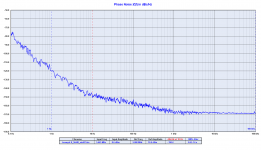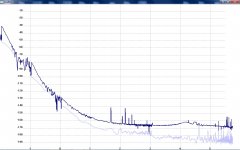Interesting stuff. I got a patent on biasing a cable to improve its linearity (5,307,416) in 1992. This paper would have helped get it through back then.
The technique works and seems legit since with a bias all the change on the cable voltage is small.
What if the dielectric is air (or mostly air) like 300 Ohm twin lead with glass spacers?
If the text is as confused as the abstract there is no reason to buy into this.The confused (re: cause and effect) abstract and relevance to the title is something only found at AES conferences.
The picture shows a wall of drivers, maybe they are onto something 😉
The intro is reminiscent of JR's ramblings. 🙂
The intro is reminiscent of JR's ramblings. 🙂
Well Scott,

You can use higher voltage in that case!What if the dielectric is air (or mostly air) like 300 Ohm twin lead with glass spacers?

I read the patent, there are two 'possible' explanations in column 8. One thing missed was the current going through the conductors causing them to attract and move towards each other, as easily demonstrated when shorting out jumper cables to get a few hundred amps going through them. With that in mind one would have to have the spacers adjacent to one another so the conductors are held stiffly apart and thus don't move and the cable doesn't change its characteristics.What if the dielectric is air (or mostly air) like 300 Ohm twin lead with glass spacers?
It's reminiscent of biased capacitors in some speaker crossovers.
This has little to do with IC cables, the currents are too small. The bias voltage also has nothing to do with magnetic effects.
Which is exactly why I am strongly suspicious about the claimed phase noise results with Andrea's oscillators. A dangling PCB beats the space grade Wenzel oscillators. The PCB is good for audio use only, of course.
Duh.. Where to start. I had received (bought) Andrea's clock(s), and obviously had been really curious about the toughest one, the 5,6448 MHz Driscoll based oscillator with the Laptech SC-cut third overtone crystal.
So here is my measurement of it. Obviously, my tool is different from Andrea's TimePod / Microsemi box. It is a beautifully executed project by Andrew Holme, PhaseNoise
Now, obviously the problems mentioned here, about thermal stability (non existent..) of an SC-cut crystal out of it's flex zone - are real. There is a constant, slow drift during operation. This drift is worse for a measurement - a typical phase noise setup works with cross-correlation, long averaging, - it definitely works out better if the signal is not drifting too much.
Then, there is a difference between how instruments deal with it. In the Timepod, visibly it had been better elaborated this part, probably the FFT's are longer, less bin with in the lower segments..
The Holme setup had been more concentrated on high quality, ovenized crystals, so less attention had been given this type of slowly drifting carrier.
In a sense, reassuming in a word. my measurement is more 'exposed', or sensitive to this problem, and it shows.
Obviously I had wrapped the oscillator in some layer of bubble wrap. Not more has been done, apart from the long waiting for thermal stabilization.
ok, so here it is:
Attachments
The confused (re: cause and effect) abstract and relevance to the title is something only found at AES conferences.
That author of that one is in the cable business. A friend opined they were not best sounding cables he ever tried. No personal experience with them myself.
Obviously I had wrapped the oscillator in some layer of bubble wrap. Not more has been done, apart from the long waiting for thermal stabilization.
Thanks, about what I was expecting, nothing else to add; obviously the close-in phase noise affects the sound, while the thermal drift doesn't
 . So much about "the best on the market, competing with Wenzel".
. So much about "the best on the market, competing with Wenzel".Product buyers, don't forget to wrap your oscillator in layers of bubble wrap, allow a couple of hours warming up before listening to music, and don't forget to suspend it by some rubber strands, to eliminate the earth crust vibrations.
What if the dielectric is air (or mostly air) like 300 Ohm twin lead with glass spacers?
I really do not know. However the original premise was that reversing the charge (+ to -) would have a more significant impact on any dielectric than a small change in the potential. If there is no dielectric (vacuum) nothing should happen. Air however still would have some stress from the potential, however small, and conceivably could react differently.
Auch!I really do not know. However the original premise was that reversing the charge (+ to -) would have a more significant impact on any dielectric than a small change in the potential. If there is no dielectric (vacuum) nothing should happen. Air however still would have some stress from the potential, however small, and conceivably could react differently.
Unless you have ca. 1400V and 25microns single wire, you are NOT right.
Ionmw,
Where is Demian wrong? He is talking about dielectric absorption in wire insulators. That is perfectly valid and affects the signal more as the impedance of the circuit rises.
-Chris
Where is Demian wrong? He is talking about dielectric absorption in wire insulators. That is perfectly valid and affects the signal more as the impedance of the circuit rises.
-Chris
Ionmw,
unlike 1audio, you have managed to make a large number of inconsistent statements in a relatively short time.
unlike 1audio, you have managed to make a large number of inconsistent statements in a relatively short time.
Come on, Chris,
Difference between vacuum and air is null in these conditions.
If stress would happen in air, that necessarily means corona conditions, at least. These conditions are tabulated, for both N2 and O2. I forgot to add that such polarization would have any observable effect only for signals over 40KHz (for lower frequencies the recombination will occur and polarization diminished exponentially).
Don't mention it, I know he still needs a primary event ("free" electron or ion): Assuming it exists, then this stress (polarization, ionization) mechanism is a very local event, surely not to be assumed over the entire length unless the audio experience takes place near the core of a reactor.
Back to dielectric stress and corona: before that to happen, probably the arc will occur on the surface of glass spacers. If the glass spacers are monocrystal quartz spacers, then, maybe you have piezo effect 🙂 Being a 300Ohm line then spacers are also large, probably a Qz resonance in audio range is not excluded 🙂
But you speak now that he refers to wire "insulators"? Ok, if conductors are covered by insulators (seems logical, although this is not the problem described), ok then other effects occur in dielectric, but yet this is a serious challenge to be measured by best instrumentation (in these conditions of 300Ohm line).
What else. If he has significant power (maybe for PA speakers at large events?), then maybe yes, he could consider mutual coupling (but Lorentz force type, not dielectric stress) and wires will buzz. Same which we hear near power lines. Now this has to happen at all frequencies: means that the 300Ohm cable subject will "buzz" the entire audio signal: becoming a mini tiny speaker. Physically possible. But did anyone record it, although is simple (put load 8Ohm, make silence, put your mike next to cable and press start record)? Hm.
Difference between vacuum and air is null in these conditions.
If stress would happen in air, that necessarily means corona conditions, at least. These conditions are tabulated, for both N2 and O2. I forgot to add that such polarization would have any observable effect only for signals over 40KHz (for lower frequencies the recombination will occur and polarization diminished exponentially).
Don't mention it, I know he still needs a primary event ("free" electron or ion): Assuming it exists, then this stress (polarization, ionization) mechanism is a very local event, surely not to be assumed over the entire length unless the audio experience takes place near the core of a reactor.
Back to dielectric stress and corona: before that to happen, probably the arc will occur on the surface of glass spacers. If the glass spacers are monocrystal quartz spacers, then, maybe you have piezo effect 🙂 Being a 300Ohm line then spacers are also large, probably a Qz resonance in audio range is not excluded 🙂
But you speak now that he refers to wire "insulators"? Ok, if conductors are covered by insulators (seems logical, although this is not the problem described), ok then other effects occur in dielectric, but yet this is a serious challenge to be measured by best instrumentation (in these conditions of 300Ohm line).
What else. If he has significant power (maybe for PA speakers at large events?), then maybe yes, he could consider mutual coupling (but Lorentz force type, not dielectric stress) and wires will buzz. Same which we hear near power lines. Now this has to happen at all frequencies: means that the 300Ohm cable subject will "buzz" the entire audio signal: becoming a mini tiny speaker. Physically possible. But did anyone record it, although is simple (put load 8Ohm, make silence, put your mike next to cable and press start record)? Hm.
Last edited:
List them.Ionmw,
unlike 1audio, you have managed to make a large number of inconsistent statements in a relatively short time.
He is talking about dielectric absorption in wire insulators. That is perfectly valid and affects the signal more as the impedance of the circuit rises.
Dielectric absorption is supposed to be a linear phenomenon, also it only acts at very low frequency, by what mechanism would it create audible distortion?
However the original premise was that reversing the charge (+ to -) would have a more significant impact on any dielectric than a small change in the potential. If there is no dielectric (vacuum) nothing should happen. Air however still would have some stress from the potential, however small, and conceivably could react differently.
A vacuum is a dielectric material as well, much more homogeneous than air, which means low distortion and small losses.
- Status
- Not open for further replies.
- Home
- Member Areas
- The Lounge
- Sound Quality Vs. Measurements

